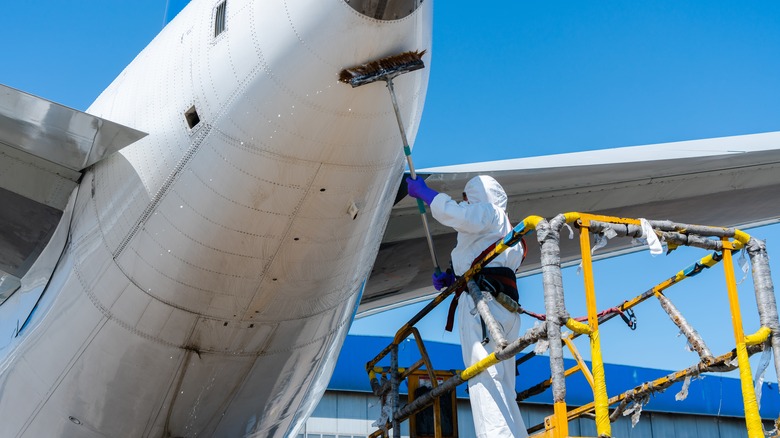The Important Reasons Aircraft Need To Be Washed So Often
While flying the friendly skies, have you ever thought about washing down an airplane? We're not talking about the inside, where we're obsessed with Clorox wiping down every square inch of the claustrophobically sized chairs, seat back trays, headrests, and the plethora of buttons and nozzles untold fingers before you have touched. No, we're talking about the actual exterior of the aircraft.
Much in the same way that muck and grime — think motor oil, roadkill, poured-out coffee, half a Big Mac — cling to our cars, so too can dirt, insects, and skykill (bird strikes) collect on airplanes that also must be washed off.
First, there's the appearance factor. Airlines want their planes to look good, and there's no better proof than showcasing a metal hull that gleams brightly under the noonday sun. Frankly, no one wants to walk onto an airplane that looks like it just flew through a haboob (an Arizona dust storm).
Secondly, regularly cleaned aircraft have a better chance of fighting off corrosion. The occasional rock, tree branch, or skykill can cause a paint chip, while atmospheric and environmental conditions like moisture, humidity, and acid rain can hasten the deterioration of the metal. Combined, a paint chip can quickly lead to rust, and no one wants to fly in a rusty fuselage.
According to an April 2021 report from Sensors, the cost of corrosion management for the commercial airline industry was $5.67 billion in 2018 alone. Meanwhile, in a May 2021 report from the U.S. Military Academy's Operation Research Center, corrosion costs the Department of Defense (DoD) over $20 billion annually in maintenance parts and labor.
Fuel efficiency matters
But there is one much bigger reason why airlines want to keep planes clean. Accumulated dirt dramatically impacts aerodynamic drag, directly affecting fuel consumption. Skin friction caused by dirt residue left on the fuselage is the leading cause of increased drag.
Dave Anderson, a Boeing Flight Operations Engineer, states that a mere 1% increase in the overall drag on a 737 will use an extra 14,979 gallons of jet fuel, equating to an additional $23,000 a year in extra fuel costs — per plane. Roughly 25,000 commercial passenger planes are circumnavigating the globe today, and approximately 4,200 of those (17%) are Boeing 737s. You do the math.
According to available data, anywhere between 17% and 28% of an airline's total operating expense typically goes to purchasing fuel. In 2022 however, fuel made up nearly 30% of those operational costs.
Planes can be washed in various ways. Some airlines use high-pressure power washing jets and special detergents. Others dry wash, a newer method using special dry cleaning agents that then get wiped off by a team of employees using mops. Emirates uses this technique and says it saves 3.1 million gallons of water annually.
Still, others run their planes through what is effectively a colossal hangar-sized automated car wash that uses high-pressure jets and massive spinning scrub brushes. Some systems can clean a plane stem to stern in as little as 30 minutes. But whatever the method used to keep planes bright and shiny, you can be sure those costs have trickled down into your ticket.
